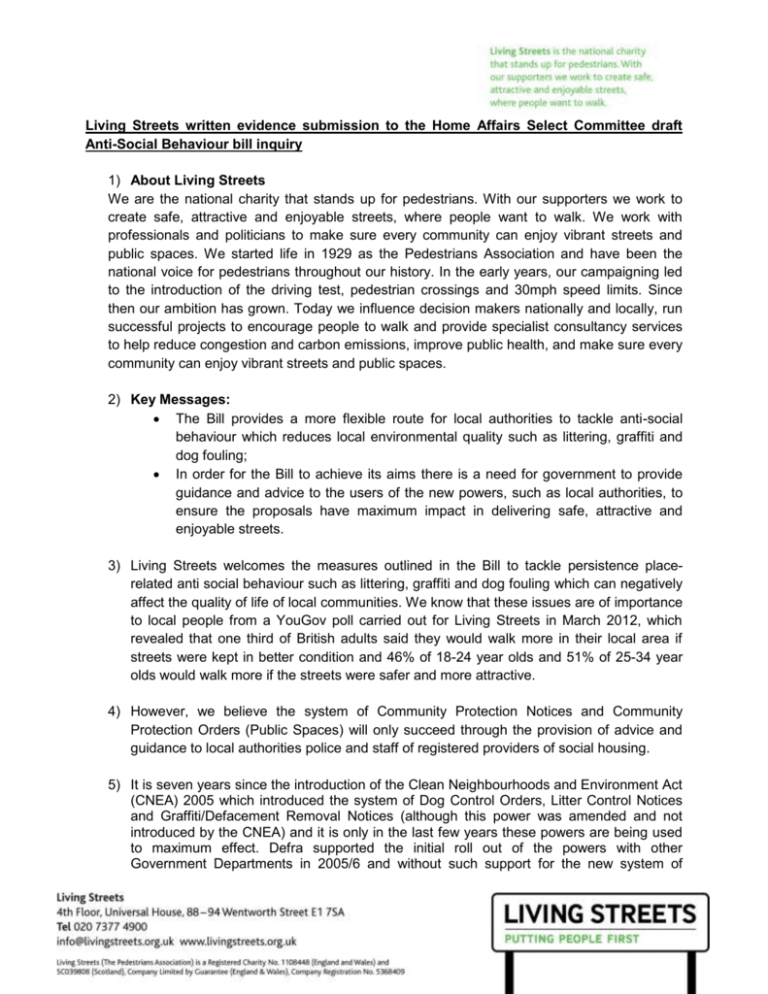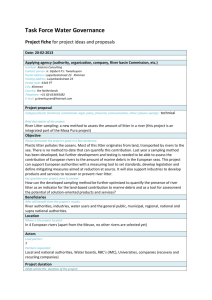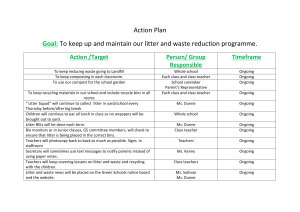Living Streets written evidence submission to the Home Affairs
advertisement

Living Streets written evidence submission to the Home Affairs Select Committee draft Anti-Social Behaviour bill inquiry 1) About Living Streets We are the national charity that stands up for pedestrians. With our supporters we work to create safe, attractive and enjoyable streets, where people want to walk. We work with professionals and politicians to make sure every community can enjoy vibrant streets and public spaces. We started life in 1929 as the Pedestrians Association and have been the national voice for pedestrians throughout our history. In the early years, our campaigning led to the introduction of the driving test, pedestrian crossings and 30mph speed limits. Since then our ambition has grown. Today we influence decision makers nationally and locally, run successful projects to encourage people to walk and provide specialist consultancy services to help reduce congestion and carbon emissions, improve public health, and make sure every community can enjoy vibrant streets and public spaces. 2) Key Messages: The Bill provides a more flexible route for local authorities to tackle anti-social behaviour which reduces local environmental quality such as littering, graffiti and dog fouling; In order for the Bill to achieve its aims there is a need for government to provide guidance and advice to the users of the new powers, such as local authorities, to ensure the proposals have maximum impact in delivering safe, attractive and enjoyable streets. 3) Living Streets welcomes the measures outlined in the Bill to tackle persistence placerelated anti social behaviour such as littering, graffiti and dog fouling which can negatively affect the quality of life of local communities. We know that these issues are of importance to local people from a YouGov poll carried out for Living Streets in March 2012, which revealed that one third of British adults said they would walk more in their local area if streets were kept in better condition and 46% of 18-24 year olds and 51% of 25-34 year olds would walk more if the streets were safer and more attractive. 4) However, we believe the system of Community Protection Notices and Community Protection Orders (Public Spaces) will only succeed through the provision of advice and guidance to local authorities police and staff of registered providers of social housing. 5) It is seven years since the introduction of the Clean Neighbourhoods and Environment Act (CNEA) 2005 which introduced the system of Dog Control Orders, Litter Control Notices and Graffiti/Defacement Removal Notices (although this power was amended and not introduced by the CNEA) and it is only in the last few years these powers are being used to maximum effect. Defra supported the initial roll out of the powers with other Government Departments in 2005/6 and without such support for the new system of Community Protection Notices and Community Protection Orders (Public Spaces) there is a serious risk of the effectiveness of these powers being reduced unintentionally as local authorities take time to understand these new powers. 6) Table One below shows a broad correlation between the numbers of Fixed Penalty Notices (FPN) issued and increased awareness and knowledge of the CNEA provisions by local authorities from 2006 until the collection of the figures stopped in 2010. Figures were not collected centrally regarding the numbers of Dog Control Orders and Graffiti/Defacement Removal Notices issued, therefore, the number of FPNs, in table one, is used a proxy measure. 7) Table One – Number of Fixed Penalty Notices issued for CNEA related offences No. FPNs for Litter Clearing Notices Issued No. of FPNs issued for graffiti No. of FPNs issued for fly-posting No. FPNs issued for dog fouling No. FPNs issued for dog control 2006/7 120 43 1133 3434 109 2007/8 257 138 1577 1938 658 2008/9 381 119 1257 2071 1306 Year Source http://data.gov.uk/dataset/fixed-penalty-notice-overview (Accessed May 2011). 8) One example of where guidance and the sharing of best practice would be useful concerns the potential use of Community Protection Notices to tackle litter outside office blocks. Under the present system of Street Litter Control Notices Sections 93 and 94 of the Environmental Protection Act 1990 give local authorities the power to issue Street Litter Control Notices on premises that have a frontage on a street, and outside which litter or refuse is causing defacement of the land. However, the legislation was originally envisaged to tackle fast food litter and till receipts, as such, notices cannot normally be served on office buildings unless they sell food and drink whether or not for consumption on the premises (e.g. from a canteen or snack kiosk). The proposed Community Protection Notice would allow local authorities to require the occupiers/owners of offices and non-food retail outlets to play a greater role in dealing with this type of litter problem and would, therefore, provide a vital tool for local authorities to deal with localised littering problems, and would close a loophole in the legislation. It would also encourage members of the public to take increased responsibility for their litter. 9) Living Streets is concerned that the use of Community Protection Notice to tackle graffiti appears to misrepresent the purpose of existing powers. Graffiti/Defacement Removal Notices are served upon building/structure owners who are not normally recipients of ASB action. The owners and occupiers of such land are, therefore, victims of anti-social behavior and are not the usual groups for which ASB action is necessary. FPNs or prosecution may take place for those who carry out graffiti or fly-posting through section 43 of the Anti Social Behavior Act 2003 and the Criminal Damage Act 1971. However, 10) Living Streets believes it is important that the new system of Community Protection Notices and Community Protection Orders (Public Spaces) retains the powers currently contained within the present system of Litter Clearing Notices which allows local authorities to recover the costs they have incurred in cleaning the property or land concerned. This is in order to prevent local communities paying twice, firstly through the amenity cost of having their quality of life reduced by neighbouring land blighted by litter and secondly the financial cost of removal through their Council Tax. 11) Finally, the 2005 Clean Neighbourhoods and Environment Act (CNEA) attempted to bring together a variety of legislation to enable land managers to improve local environmental quality. To ensure the primary legislation achieved these aims a variety of secondary legislation and guidance was reviewed or introduced. One such area of guidance which was reviewed was the Code of Practice on Litter and Refuse (COPL&R) which was introduced to set minimum standards which communities could expect from their local authorities and statutory providers. Accordingly the Litter Control Notice sections of the CNEA are linked with the COPL&R. 12) Section 92A of the Environmental Protection Act as amended by Sec 20 of the CNEA allows a Litter Clearing Notice to specify the standards of compliance. The standards of compliance for Litter Clearing Notices are detailed in the COPL&R. Therefore, any repeal of the system of Litter Control Notices would need to be linked with a review of COPL&R to ensure minimum standards of compliance are achieved by landowners when removing litter and refuse from their land. For more details please contact: Dr Kevin Golding-Williams - Public Affairs and Policy Manager kevin.golding-williams@livingstreets.org.uk Tel: 020 7377 4907 Mobile: 07720 680603





